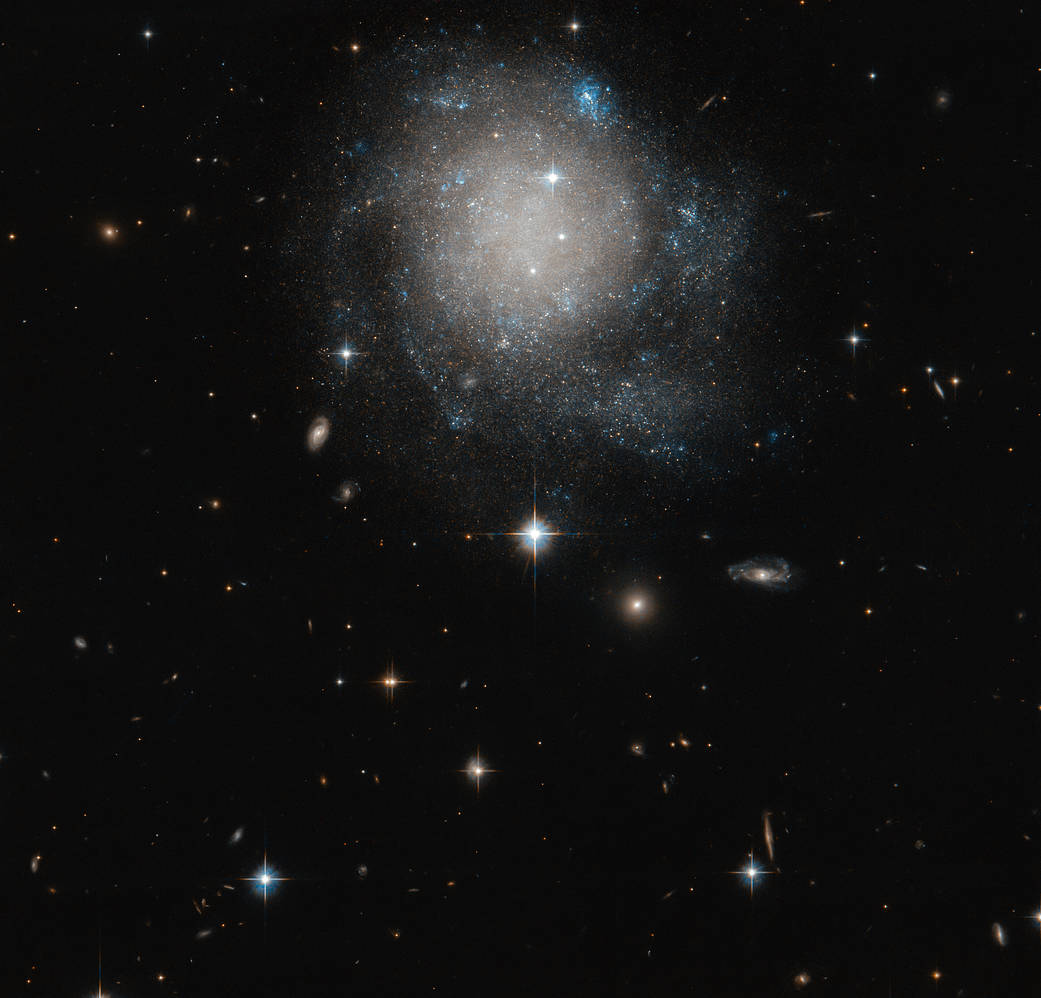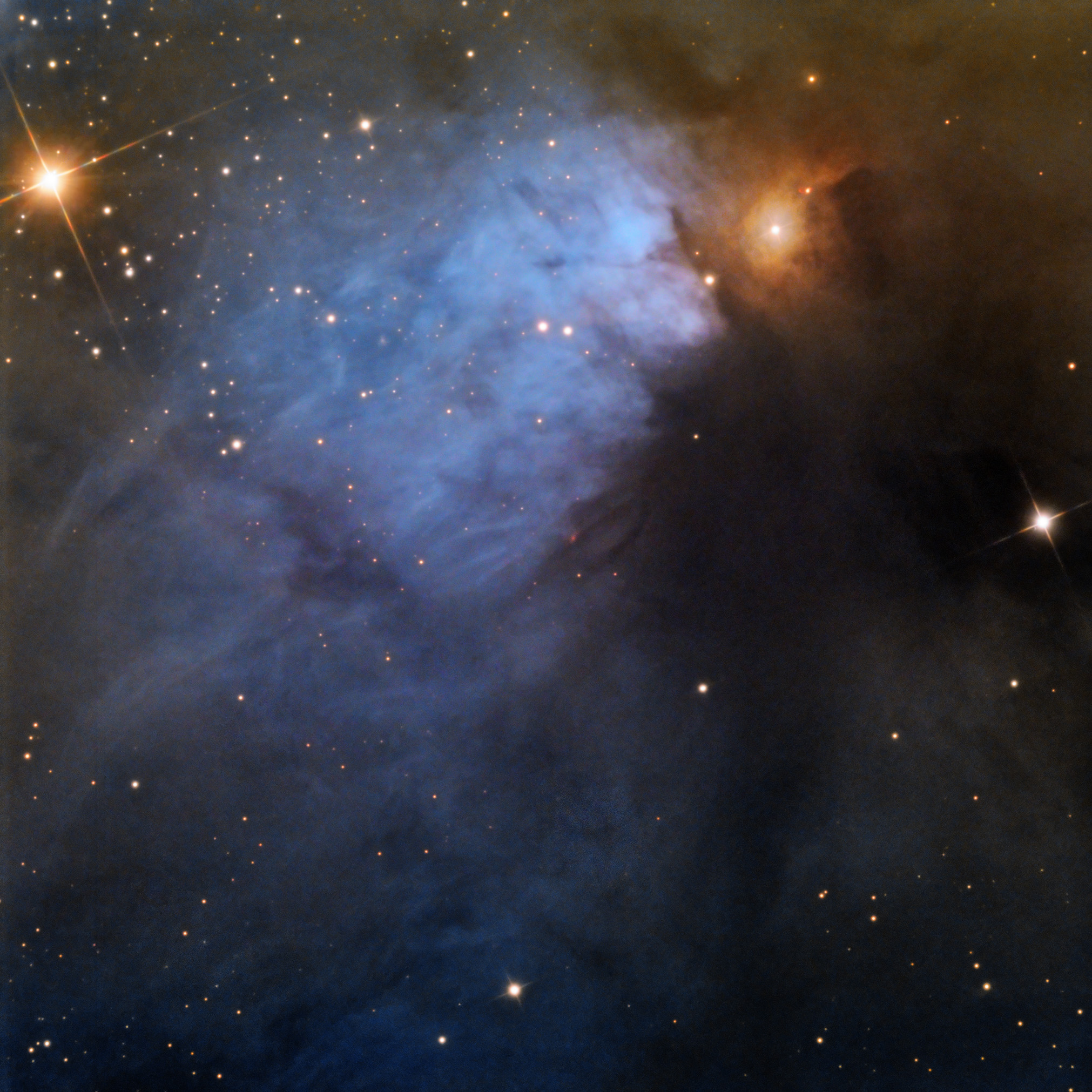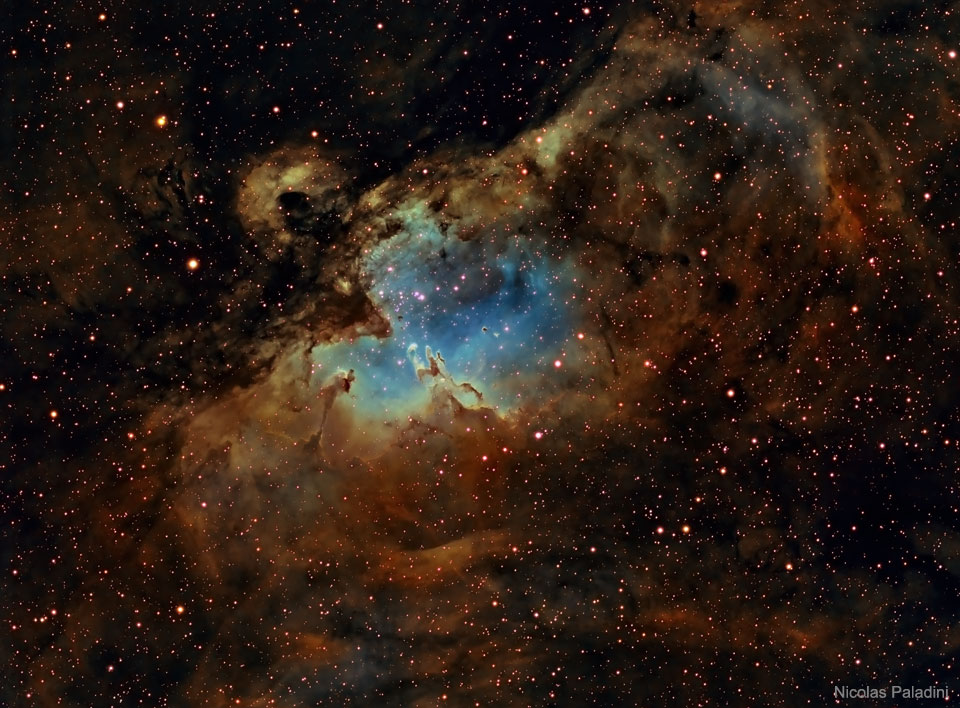Blog
Observed with the NASA/ESA Hubble Space Telescope, the faint galaxy featured in this image is known as UGC 12588. Unlike many spiral galaxies, UGC 12588 displays neither a bar of stars across its center nor the classic prominent spiral arm pattern. Instead, to a viewer, its circular, white and mostly unstructured center makes this galaxy more reminiscent of a cinnamon bun than a megastructure of stars and gas in space.
Lying in the constellation of Andromeda in the Northern Hemisphere, this galaxy is classified as a spiral galaxy. Unlike the classic image of a spiral galaxy, however, the huge arms of stars and gas in UGC 12588 are very faint, undistinguished, and tightly wound around its center. The clearest view of the spiral arms comes from the bluer stars sprinkled around the edges of the galaxy that highlight the regions where new star formation is most likely taking place.

Patricia Lee Smith (born December 30, 1946) is an American singer-songwriter, musician, author, and poet who became an influential component of the New York City punk rock movement with her 1975 debut album Horses.
Called the “punk poet laureate”, Smith fused rock and poetry in her work. Her most widely known song is “Because the Night“, which was co-written with Bruce Springsteen. It reached number 13 on the Billboard Hot 100 chart in 1978 and number five in the U.K. In 2005, Smith was named a Commander of the Ordre des Arts et des Lettres by the French Ministry of Culture. In 2007, she was inducted into the Rock and Roll Hall of Fame.
On November 17, 2010, Smith won the National Book Award for her memoir Just Kids. The book fulfilled a promise she had made to her former long-time roommate and partner, Robert Mapplethorpe. She placed 47th in Rolling Stone magazine’s list of 100 Greatest Artists published in December 2010 and was also a recipient of the 2011 Polar Music Prize.
Patricia Lee Smith was born in 30 December 1946 at Grant Hospital of Chicago in Chicago to Beverly Smith, a jazz singer turned waitress, and Grant Smith, who worked as a machinist at a Honeywell plant. The family was of part Irish ancestry and Patti was the eldest of four children, with siblings Linda, Kimberly, and Todd. At the age of 4, Smith’s family moved from Chicago to Germantown, Philadelphia, before heading to Pitman, New Jersey and later to The Woodbury Gardens section of Deptford Township, New Jersey.
more...John Cowan Hartford (December 30, 1937 – June 4, 2001) was an American folk, country, and bluegrass composer and musician known for his mastery of the fiddle and banjo, as well as for his witty lyrics, unique vocal style, and extensive knowledge of Mississippi River lore. His most successful song is “Gentle on My Mind“, which won three Grammy Awards and was listed in “BMI’s Top 100 Songs of the Century”. Hartford performed with a variety of ensembles throughout his career, and is perhaps best known for his solo performances where he would interchange the guitar, banjo, and fiddle from song to song. He also invented his own shuffle tap dance move, and clogged on an amplified piece of plywood while he played and sang.
Harford (changed his name to Hartford later in life at the behest of Chet Atkins) was born on December 30, 1937, in New York City to parents Carl and Mary Harford. He spent his childhood in St. Louis, Missouri, where he was exposed to the influence that shaped much of his career and music: the Mississippi River. From the time he got his first job on the river, at age 16, Hartford was on, around, or singing about the river.
https://www.youtube.com/watch?v=G8HvNot3ZbY
more...Ellas McDaniel (born Ellas Otha Bates; December 30, 1928 – June 2, 2008 McComb, MS), known as Bo Diddley, was an American singer, guitarist, songwriter and music producer who played a key role in the transition from the blues to rock and roll. He influenced many artists, including Buddy Holly, Elvis Presley, the Beatles, the Rolling Stones, the Animals, and the Clash.
His use of African rhythms and a signature beat, a simple five-accent hambone rhythm, is a cornerstone of hip hop, rock, and pop music. In recognition of his achievements, he was inducted into the Rock and Roll Hall of Fame in 1987, the Blues Hall of Fame in 2003, and the Rhythm and Blues Music Hall of Fame in 2017.He received a Lifetime Achievement Award from the Rhythm and Blues Foundation and the Grammy Lifetime Achievement Award. Diddley is also recognized for his technical innovations, including his distinctive rectangular guitar, with its unique booming, resonant, shimmering tones.
more...Jack Montrose (December 30, 1928 – February 7, 2006) was a jazz tenor saxophonist and arranger. After attending college in Los Angeles, he worked with Jerry Gray and then Art Pepper. Montrose also did arrangements for Clifford Brown. He became known for cool jazz and/or West coast jazz.
Montrose was born in Detroit. Beginning in the mid-1950s Montrose’s heroin addiction became a liability and by the time he had overcome it his style of jazz was no longer popular. This led him to play in strip joints for a time until he relocated to Las Vegas where he worked in casinos. Montrose returned to recording in 1977 and in 1986 had some success in collaboration with Pete Jolly.
Jack Montrose (West Coast Jack) is not to be confused with tenorist J.R. Monterose (East Coast Jake) who played on Charles Mingus‘s album Pithecanthropus Erectus. He died in Las Vegas.
more...This little blue nebula is so inconspicuous, it is often overlooked in favor of bigger and brighter nebulae. Found among a rich field of nebulae within the constellation of Taurus, it’s extremely rare to see it isolated—let alone in such gloriously high-resolution.
Called Cederblad 30 (otherwise known as LBN 782, with LBN standing for Lynds Bright Nebula), this small fan-shaped region is classified as a reflection nebula, and given the dark underpinning of its surrounding—it’s like a glimmer of light in a smoky, black pit (it really, really is). Running around and through Cederblad 30 are numerous dark nebulae, which aren’t clear in this particular image.
I wasn’t able to find too much information about this one either (which seems to be happening a lot these days), but I did stumble upon something that talked about Cederblad 30 often being mistaken for IC 359, and the mix-up goes all the way back to the days in which Edwin Hubble was compiling his deep sky catalog.

Marianne Evelyn Gabriel Faithfull (born 29 December 1946) is an English singer, songwriter, and actress. She achieved popularity in the 1960s with the release of her hit single “As Tears Go By” and became one of the lead female artists during the British Invasion in the United States.
Born in Hampstead, London, Marianne Faithfull began her career in 1964 after attending a Rolling Stones party, where she was discovered by Andrew Loog Oldham. After the release of her hit single “As Tears Go By“, she became an international star. Her debut album Marianne Faithfull (1965) (released simultaneously with her album Come My Way) was a commercial success followed by a number of albums on Decca Records. From 1966 to 1970, she had a highly publicised romantic relationship with Mick Jagger. Her popularity was further enhanced by her film roles, such as I’ll Never Forget What’s’isname (1967), The Girl on a Motorcycle (1968), and Hamlet (1969). However, her popularity was overshadowed by personal problems in the 1970s. During that time she was anorexic, homeless, and a heroin addict.
Noted for her distinctive voice, Marianne Faithfull’s previously melodic and higher registered vocals (which were prevalent throughout her career in the 1960s) were affected by severe laryngitis, coupled with persistent drug abuse during the 1970s, permanently altering her voice, leaving it raspy, cracked and lower in pitch. This new sound was praised as “whisky soaked” by some critics for helping capture the raw emotions expressed in her music. After a long commercial absence, Marianne Faithfull made a comeback with the 1979 release of her critically acclaimed album Broken English. The album was a commercial success and marked a resurgence of her musical career. Broken English earned Faithfull a nomination for Grammy Award for Best Female Rock Vocal Performance and is often regarded as her “definitive recording”. She followed with a series of albums, including Dangerous Acquaintances (1981), A Child’s Adventure (1983), and Strange Weather (1987). Faithfull also wrote three books about her life: Faithfull: An Autobiography (1994), Memories, Dreams & Reflections (2007), and Marianne Faithfull: A Life on Record (2014).
Marianne Faithfull is listed on VH1‘s “100 Greatest Women of Rock and Roll” list. She received the World Lifetime Achievement Award at the 2009 Women’s World Awards and was made a Commandeur of the Ordre des Arts et des Lettres by the government of France.
more...Richard Clare Danko (December 29, 1943 – December 10, 1999) was a Canadian musician, bassist, songwriter and singer, best known as a founding member of The Band. During the 1960s, Danko performed as a member of the Hawks, backing Ronnie Hawkins and then Bob Dylan. Then, between 1968 and 1977, Danko and the Hawks, now called the Band, released seven studio albums before the band broke up. In the late 1990s, up until his death, Danko participated in the Band’s partial reunion.
It was Danko who found the pink house on Parnassus Lane in Saugerties, New York, which became known as Big Pink. Danko, Hudson, and Manuel moved in, and Robertson lived nearby. The Band’s musical sessions with Dylan took place in the basement of Big Pink, between June and October 1967, generating recordings that were officially released in 1975 as The Basement Tapes. In October, the Hawks began demo recordings for their first album, with Helm rejoining the group in that month. Their manager, Albert Grossman, secured them a recording deal with Capitol Records in late 1967.
From January to March 1968, the Band recorded their debut album, Music from Big Pink, in recording studios in New York and Los Angeles. On this album, Danko sang lead vocal on three songs: “Caledonia Mission”, “Long Black Veil” and “This Wheel’s on Fire.”
more...Joseph Salvatore Lovano (born December 29, 1952) is an American jazz saxophonist, alto clarinetist, flautist, and drummer. He has earned a Grammy Award and several mentions on Down Beat magazine’s critics’ and readers’ polls. He is married to jazz singer Judi Silvano with whom he records and performs. Lovano was a longtime member of a trio led by drummer Paul Motian.
Lovano was born in Cleveland, Ohio, United States, to Sicilian-American parents; his father was the tenor saxophonist Tony (“Big T”) Lovano. His father’s family came from Alcara Li Fusi in Sicily, and his mother’s family came from Cesarò, also in Sicily. In Cleveland, Lovano’s father exposed him to jazz throughout his early life, teaching him the standards, as well as how to lead a gig, pace a set, and be versatile enough to find work. Lovano started on alto saxophone at age six and switched to tenor saxophone five years later. John Coltrane, Dizzy Gillespie, and Sonny Stitt were among his earlier influences. After graduating from Euclid High School in 1971, he went to Berklee College of Music, where he studied under Herb Pomeroyand Gary Burton. Lovano received an honorary doctor of music degree from the college in 1998.
more...Matthew Tyler Murphy (December 29, 1929 – June 15, 2018), known as Matt “Guitar” Murphy, was an American blues guitarist. He was associated with Memphis Slim, The Blues Brothers and Howlin’ Wolf. Murphy was born in Sunflower, Mississippi, and was educated in Memphis, Tennessee, where his father worked at the Peabody Hotel. Murphy learned to play guitar when he was a child.
In 1948, Murphy moved to Chicago, where he joined the Howlin’ Wolf Band, which at the time featured Little Junior Parker. In 1952, Murphy recorded with Little Junior Parker and Ike Turner, resulting in the release, “You’re My Angel”/“Bad Women, Bad Whiskey”(Modern 864), credited to Little Junior Parker and the Blue Flames.
Murphy worked often with Memphis Slim, including on his debut album At the Gate of Horn (1959). Murphy recorded two albums with Chuck Berry and was also featured in works by Koko Taylor, Sonny Boy Williamson II, Buddy Guy, Etta James, and Otis Rush. He also performed with Willie Dixon. He gave a memorable performance in 1963 on the American Folk Blues Festival tour of Europe with his “Matt’s Guitar Boogie”. Freddie King is said to have once admitted that he based his “Hide Away” on Murphy’s playing during this performance.
more...From afar, the whole thing looks like an Eagle. A closer look at the Eagle Nebula, however, shows the bright region is actually a window into the center of a larger dark shell of dust. Through this window, a brightly-lit workshop appears where a whole open cluster of stars is being formed. In this cavity tall pillars and round globules of dark dust and cold molecular gas remain where stars are still forming. Already visible are several young bright blue stars whose light and winds are burning away and pushing back the remaining filaments and walls of gas and dust. The Eagle emission nebula, tagged M16, lies about 6500 light years away, spans about 20 light-years, and is visible with binoculars toward the constellation of the Serpent (Serpens). This picture involved over 12 hours of imaging and combines three specific emitted colors emitted by sulfur (colored as red), hydrogen (yellow), and oxygen (blue).

Michel Petrucciani (French pronunciation: [miʃɛl petʁutʃani]; Italian: [petrutˈtʃaːni]; 28 December 1962 – 6 January 1999) was a French jazz pianist. From birth he had osteogenesis imperfecta, a genetic disease that causes brittle bones and, in his case, short stature. He became one of the most accomplished jazz pianists of his generation despite having pain in his arms. Michel Petrucciani came from an Italo-French family (his grandfather was from Naples) with a musical background. His father Tony played guitar, his brother Louis played bass, and his brother Philippe also plays the guitar. Michel was born with osteogenesis imperfecta, which is a genetic disease that causes brittle bones and, in his case, short stature. It is also often linked to pulmonary ailments. The disease caused his bones to fracture over 100 times before he reached adolescence and kept him in pain throughout his entire life. “I have pain all the time. I’m used to having hurt arms,” he said In Michel’s early career, his father and brother occasionally carried him because he could not walk far on his own unaided. In certain respects he considered his disability an advantage, as he got rid of distractions like sports that other boys tended to become involved in. And he hints that his disability was helpful in other parts of his life. He said: “Sometimes I think someone upstairs saved me from being ordinary.”
more...More Posts
- Big Mama Thornton
- World Music Trio Mandili
- Daily Roots Joya Landis Tommy McCook & the Supersonics
- World Human Rights Day 2023
- Cosmos NGC7635 SH2-157 HOO
- Bob Cranshaw
- Ray Nance
- Morton Gould
- World Music Trio Matamoros
- Daily Roots Junior Delgado
- Cosmos M16
- Dan Hicks
- Jessie Hill
- Junior Wells
- Donald Byrd
- World Music Arja Kastinen
- Daily Roots Wayne Jarrett
- Shabbat for the Soul Mt Zion
- Cosmos Vega & Comet 12P/Pons-Brooks
- Jim Morrison